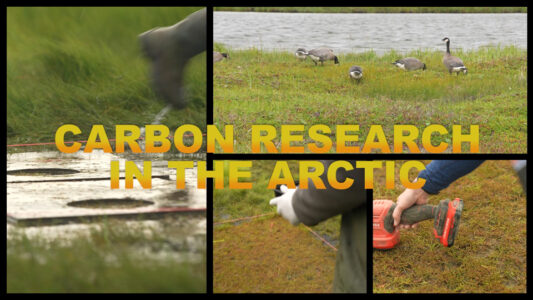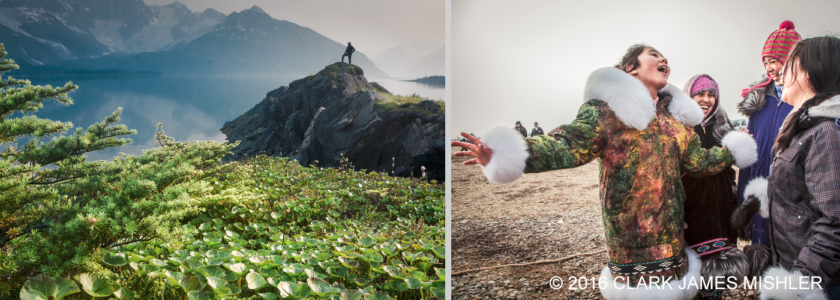
“It never ceases to amaze me. No matter what the conditions are, what time of year it is, the place still awes me.” ~ Patricia Owen, wildlife biologist, Denali National Park & Preserve
Cold nights have prompted the Denali landscape to turn colors; reds and purples are spectacular tundra accents spread across the wild vista. We’re at Denali National Park & Preserve meeting park rangers and scientists; searching for bears.
While park visitor numbers are usually calculated to number about 400,000 annually, last year (2013) the park reported 530,911 visits. That’s great. People are getting outdoors, enjoying our public lands. Denali National Park & Preserve boasts 6,075,028.96 acres of breathtaking Alaskan mountains, tundra, and forest. I’m always eager to return.
Of those visitors, about 20% are “Intrepid explorers,” who load up packs and venture into the trailless backcountry, says Kristin Knight Pace, lead backcountry ranger at Denali National Park & Preserve.
In her spare time she’s a dog musher. Kristin and her husband keep a kennel of 30 dogs: the Hey Moose! Kennel in Healy, Alaska. She’ll be competing in the Yukon Quest this year. “I just knew in my heart that it was something I had to do,” Kristin says. Her passion was inspired by working for the Denali National Park Sled Dog Kennels during the summer of 2006.

…What she says is a sentiment echoed by so many in Alaska who live and work in the outdoors. These are people with steady, passionate hearts.
“Ever since I came to Alaska I haven’t daydreamed a single day,” Kristin says. “– I mean, I’m living it!”
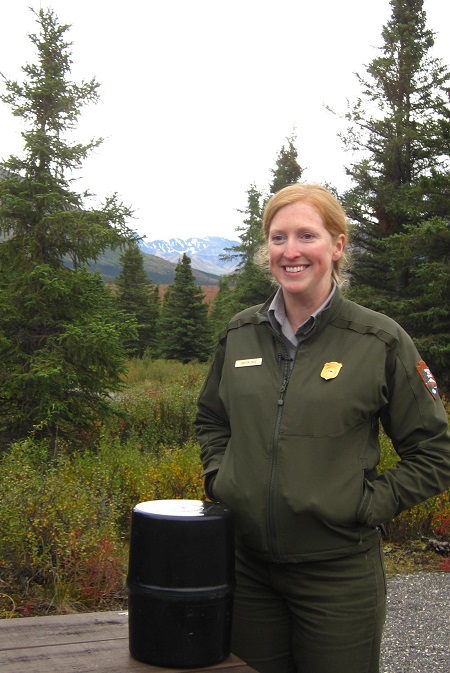
Backcountry information
At Denali National Park & Preserve’s Backcountry Information Center, hikers obtain a free backcountry permit by watching a safety information video, attending a ranger-led safety talk and orientation, and delineate backcountry unit boundaries and closures on a topographic map. “It’s all going to be based on your ability to navigate in the trailless wilderness,” Kristin explains. The rangers encourage hikers to plan their travel through backcountry wilderness units equivalent with their skill level.
Hikers stay anywhere from 1 to 30 nights. They’re assigned to different wilderness areas to minimize the human impact on the park. They’re also required to use free park-loaned bear canisters. During the night, campers must cook 100 meters away from their tents, and keep bear canisters with all food and scented goods (i.e. soap, sunscreen, chapstick) 100 meters from tents and from cooking areas.
Each bear canister is designed to be bear resistant. However, bears are clever and intensely curious, so the park regularly updates canisters. New designs keep bears guessing. New canister models are sometimes even tested on zoo bears. Since bear-resistant food canisters were introduced in Denali in 1984, there’s been a 95% decrease in bears obtaining backpacker’s food. These canisters keep bears from associating food rewards or the smell of food with human beings.
Bears are curious, especially sub-adults newly away from their mother’s watchful eye. This year hikers returned to their camp from a day hike to find a grizzly bear investigating their tent’s contents. They smartly headed back to the road and reported the incident to park rangers.
“We have odors, our gear smells.” Denali National Park & Preserve wildlife biologist Patricia Owen explains: “The way they investigate is to paw at things, to bite at things, and that causes damage to our gear.”
Rangers closed the area to hikers and set up mock-tents to check whether any local bears might repeat the behavior.
Backcountry rangers patrol in pairs, spending 3-8 day stretches in Denali’s mighty wilderness. They engage in search and rescue when hikers encounter problems. They also aid in scientific studies, for example: installing and maintaining sound monitoring machinery, assisting in archaeological surveys by documenting and collecting any unusual finds. Kristin says this year they’ve found 5 or 6 prehistoric blinds and food caches. They’ve also dealt with an unusual amount of rain. “The park is always in flux, and we get to be out there witnessing that.”
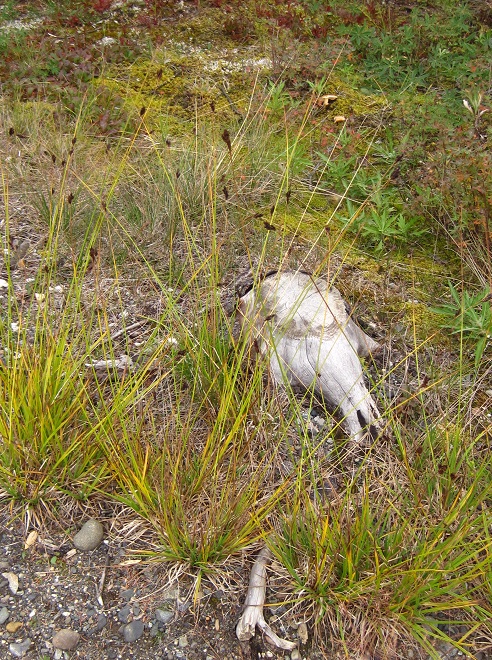
“The wildlife, they are equipped to survive out here; we’re not,” Kristin says. Recorded park temperatures range from a cold of -54°F [-48ºC] to a hot of 91°F [33ºC] (record temperatures measured at park headquarters). That’s one of the reasons careful planning is required, but it’s also a draw. Hikers come here seeking adventure.
And they find it.
One of the reasons Kristin loves going out in the field?: “To be able to test myself.” She says some of her first hikes were rough experiences – real reality checks. Over and over, I hear her use the word “Humbling” as she describes Denali’s wilderness. “Humbling and rewarding.” It must be; those rough experiences seemed to have served as inspirations for more adventures. Her backcountry resume lists enough hiking expedition experiences to fill 15 pages.
Wildlife encounters
What was this backcountry ranger’s scariest experience? A bear encounter. Kristin isn’t just a ranger and musher, she’s also a very talented storyteller, but I’ll recount her story in short. She and her husband had lost their bear spray (much like pepper spray but formatted to work against Ursus arctos) during a rough river crossing. They hiked a pass, beautiful tundra boasting the kind of endless visibility in every direction that helps you start to grasp the breathtaking space of the state of Alaska, and yet they were not alone. A bear emerged from a divot in the rolling tundra not 20 feet away. They’d startled the grizzly; the bear ran off a short distance then squared off as though to charge, huffing and gnashing teeth.
Kristin and Andy stood together to look bigger, slowly waving their arms and speaking in low tones to help the bear identify them. They did not run (bears can run faster than 30 miles per hour [50 km/hr], and running can elicit a chase response) but instead backed away slowly. Following the recommended methods worked like a charm, and the bear calmed and also retreated: “We would both go 50 yards, then turn and look at each other, then repeat. Finally, we were out of sight of each other.”
“It was a textbook bear encounter, it went perfectly,” Kristin says, then adds: “But it was totally terrifying.”
Recounting the story, Kristin adds: “The encounter, once it began, went perfectly. But we could have avoided it if we had been more bear aware and made a better attempt not to surprise any animals.” They’d felt a sense of security due to the expansive view, but talking loudly or singing while traveling are great way to keep from surprising any hidden residents.
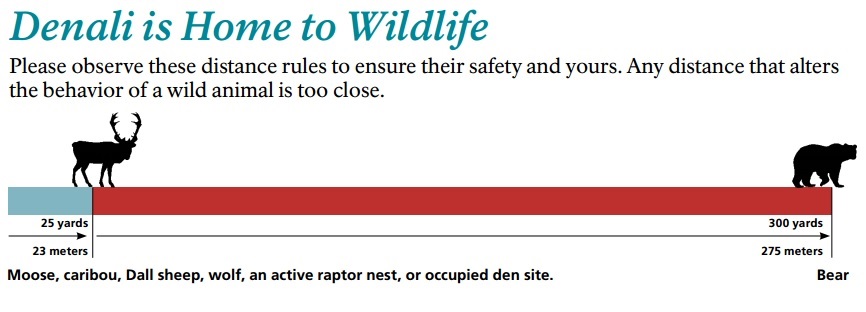
Wildlife biologist Patricia Owen is a grizzly bear expert. She notes: that sort of encounter happens when people surprise bears, or approach too near. That’s why the park requires humans keep a 300 yard [275 meter] distance from bears. Hikers can shout, sing, or even wear loud-jangling bells to warn bears of their approach. Sometimes, though, people end up in uncomfortable proximity to a bear. “In cases like that, the bear really wants you out of their space,” Pat explains. And failing that, the bear wants the intruder subdued.
If a grizzly bear does charge, park guideline recommend standing your ground, not running. Bears will often stop or veer off before actually making contact. If a grizzly bear does make contact, the best measure is to curl up and play dead as the bear briefly investigates you. This lets the bear assure itself that you are not a threat. On the other hand, black bears are different… unlike grizzly bears, black bears’ intent is often predatory. Park guidelines say that if a black bear makes contact with you, fight back immediately.
Grizzly bears and brown bears are actually the same species: Ursus arctos. Grizzlies live in the interior, like Denali, subsisting mostly on berries and small prey. Brown bears live mainly along Alaska’s southern coast. They grow large off the seasonally abundant salmon that travel upstream to spawn.

Pat is a keen shot. She tranquilizes grizzlies (often from a helicopter), then takes measurements and equips the bears with tracking collars. Her work studying grizzly bear behavior for research and management purposes helps keep Denali’s bear population healthy and wild. (The park’s efforts to keep bears from becoming acclimated to humans and their food have been highly successful… unlike in some other parts of the United States, Denali bears still have no idea what a cooler is.)
Knowing she’s worked on bears while they lay in a drug-filled haze, and that she has sometimes has to boost tranquilizer doses when particularly massive bears start to stir early, I was surprised to hear that her scary encounter story was not with a bear, but with a moose.
“One of the most frightening animal encounters I ever had was with a huge bull moose,” Pat confides. She was not so far from the entrance of the park, between mile 6.5 and 11.5 of the road. At the time park visitors were forbidden to leave the roadside for their safety – it was the middle of the moose rutting season. Pat encountered a huge bull moose. “He was just beside himself,” she recalls. The moose was smelling the scents of female moose cows, then running in widening circles, “Totally worked up.” Pat had been standing something like 50 yards away from the bull (the minimum distance from moose is 25 yards) but the animal’s path took him alarmingly close. “To see him bearing down on me, I thought: ‘Oh my gosh, I’m going to get run over!’” The bull’s running path veered just shy of the spruce tree Pat stood alongside.
A trailless ideal
Animals in the park are doing their thing: seeking food and shelter, breeding and rearing young. The human visitors are the the interlopers, mere visitors to this mighty wilderness.

Some outdoor ethics for traveling Denali include ‘Leave No Trace’ and ‘Camp and Travel on Durable Surfaces’.
Pat Owen talks about leading highschool students into the park as part of a Biological Intensive training course. The educational expedition brought local students into the park. While Pat didn’t originally imagine her position would involve working as an educator, she’ll admit: “They definitely get a different perspective from me.” The education initiatives will hopefully inspire. Pat says: “We’re training the next generation of conservators.”
I, for one, fondly remember my days as a Junior Ranger.
When Pat came upon a too-well defined foot trail high on mountain slopes, she led the students to ascend along untrodden ground. That ideal of a trailless wilderness seems one she holds close. When she talks about trails made by hikers too closely following someone else’s path, she says they’re “Scars” on the land. “I mean that trail will never ever – in our lifetimes, and probably three others – heal itself.” Ethical visitation can help the park remain a wilderness.
Denali is all about the unbeaten trail.
Laura Nielsen
Frontier Scientists: presenting scientific discovery in the Arctic and beyond
Grizzlies project
- Interviews with park staff, August 2014
- ‘Alpenglow: Summer 2012’ Denali National Park & Preserve; Alaska Geographic Association (Summer 2012)
http://www.nps.gov/dena/parknews/upload/alpenglow-summer-2012.pdf - ‘Denali 2014 Fact Sheet’ National Park Service, U.S. Department of the Interior (March 2014)
http://www.nps.gov/dena/parkmgmt/upload/fact2014-March-final.pdf
